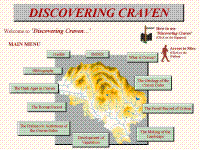
Figure 1: Discovering Craven main menu
Cite this as: Falkingham, G. 2003 Review of Discovering Craven, Richard Harland Collection and Craven Museum Lithics Collections, Internet Archaeology 14. https://doi.org/10.11141/ia.14.9
Discovering Craven: an interactive exploration of the Geology, Landscape History and Archaeology of the Craven Area
of the Yorkshire Dales National Park. CD-Rom. Written and designed by Trevor Croucher DataGraphics 2000.
Designed to run on Windows 95, Windows 98 or later.
Available from http://www.nmvdigital.com
Price: £27.50 including p&p within UK
The Richard Harland Collection of flint and other lithic artefacts from North and East Yorkshire Deposited in the
Hull City Museum. CD-Rom. Designed and compiled by Trevor Croucher. June 2000. Designed to run on Microsoft Access 97
or later, requiring 60Mb of free disk space.
Available from the Hull and East Riding Museum Price:
£10 plus p&p
The Craven Museum Lithics Collections: A Virtual Catalogue of the Lithics Collections held by the Craven Museum,
Skipton, North Yorkshire. 2 x CD-Rom. Compiled by Trevor Croucher and John Richardson. April 2003. Designed to run on
Microsoft Windows 98 or later and Microsoft Access 2000 or later, requiring 1.02Gb of free disk space.
Available from the Craven Museum
Price: £20 per set, plus p&p
These three CD-Roms have been produced by Trevor Croucher DataGraphics. The first, Discovering Craven, is an interactive guide to the Craven area of North Yorkshire. The other two are virtual catalogues of the 'Richard Harland Lithics Collection' of the Hull and East Riding Museum in 2000, and, most recently, the prehistoric lithics collections of the Craven Museum, Skipton, in 2003.
Discovering Craven is aimed at the general reader, and provides a beautifully illustrated and presented interactive CD-Rom, created with Illuminatus Interactive. Craven is one of the seven districts within the county of North Yorkshire, a large area of which falls within the Yorkshire Dales National Park.

Figure 1: Discovering Craven main menu
As if viewing an electronic book, the user can explore the geology, landscape history and archaeology of Craven up to the early medieval period. There are 226 pages in total, each with a nicely balanced combination of text and images, including photographs, digital location maps, site plans and 3-D landscape models that are mostly in colour. The Digital Maps have been created by Pioneer GIS and Mapping (Graffix Systems Ltd.) using Bartholomew GB 1:25000 digital map data; the 3-D landscape models using Visual Explorer (Woolleysoft) with contour data from the Ordnance Survey Land-Form Panorama DTM. With the appropriate screen resolution of 1024 x 768 pixels, the full page layout automatically fills the screen, thus avoiding the need to scroll up and down, or maximise the window.
The 'book' is divided into eight main sections, accessible from buttons on the main menu (see Fig. 1), comprising 25 chapters; an overview of each is given at the beginning of each section to give a clear idea of content. The user can choose their own route through the CD-Rom, facilitated by navigation buttons in the bottom right-hand corner of the screen, with the option of returning to the main menu on every page. Each page is numbered and there is also an alphabetical index that can be opened from the main menu, and minimised for ease of reference, that takes the reader to specific pages through hypertext links.
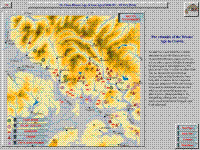
Figure
2: Screen shot showing interactive digital distribution map of Bronze Age remains in Craven
Selected images and digital maps have pop-up keys to open supplementary windows providing details of the sites shown and/or additional illustrations. As the CD-Rom was initially produced for the Craven Museum in Skipton, many pages have a button to open windows with specific information about related geological and archaeological exhibits within the museum, which readers are encouraged to visit.
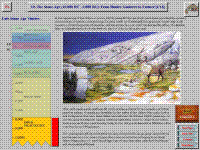
Figure 3a: Screen shot of main page
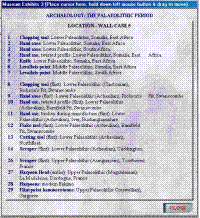

Figure 3b (left): pop-up window listing display items from the Palaeolithic period in the Craven Museum, Skipton.
Figure 3c (right): Subsequent page from Stone Age chapter
In addition, there is an extensive bibliography of further sources of information, although there is no mention of the Sites and Monuments Records held both by North Yorkshire County Council and the Yorkshire Dales National Park.

Figure 4: Screen shot showing illustrated page relating to stalactites and stalagmites in Stump Cross
Caves, Craven.
This is a very attractive and user-friendly guide to the Craven area. A wealth of information is included, with clear and eye-catching diagrams and images that are of educational value, and of interest and use to both the general reader and the specialist alike.
One of the main advantages of this CD-Rom format is that the cost of printing the equivalent content as a hard copy publication with so many full colour illustrations would, no doubt, be prohibitive. The CD-Rom format is cheaper to produce and distribute, is a compact and portable medium that takes up little physical storage space and allows quick access to a large amount of data. There is, nevertheless, the issue of the long-term preservation of the data held on CD-Rom, which, under the right conditions may be durable for up to thirty years (Perkins 1997). The content can, however, be copied easily onto the hard drive of the reader's computer.
The Richard Harland Collection and Craven Museum Lithics Collection CD-Roms present virtual catalogues of collections held in the Hull and East Riding, and Craven Museums.
In 1999, the authors were approached by local collector, Richard Harland, to document a relatively small collection of 2,424 prehistoric flint and other lithic artefacts from the North York Moors and the Yorkshire Wolds, covering more than twenty sites from areas of the present north and east Yorkshire.
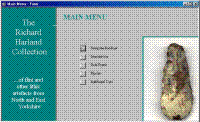
Figure
5: Screen shot from the main switchboard of the database
This assemblage of material represents a collection amassed between the early 1930s and 1950s, which has recently been deposited with the Hull and East Riding Museum, Hull. As the press release issued by the museum remarks, the project has made "old finds available through new technology".
The authors of both these virtual catalogues of flint material have produced an innovative approach to documenting these collections in a digital format. The aim of the project was to design a relational database using Microsoft Access that would be applicable not only to the Harland Collection, but to other similar collections of artefacts. The database does not create a detailed and analytical research report, but a fairly basic classification system to record the collection, with illustrations. The cataloguing of material was a requirement of the museum's acceptance of the collection and the authors' intention to make the raw data available electronically, leaving further detailed work up to individual researchers. The design of the database has aimed to provide an effective solution to the problem of accurately recording and cataloguing a large number of items within the museum, and to make people aware of what is available for study (Only a small percentage of the lithics are on display; the vast majority are stored within the archives behind the scenes).
The main catalogue of the Richard Harland Collection CD comprises a database of all 2,424 artefacts, using Microsoft Access 97. The Main Switchboard of the database (see Figure 5) provides the option of opening instructions on how to use the database, as well as a document providing a personal introduction to the catalogue by Richard Harland, detailing his passion for flint collecting and the history of his acquisitions. There are links to the main data form and to a series of reports for querying and viewing data.

Figure 6: Main data form 'FlintData' showing individual flint record
The main data form, 'FlintData', is the central form of the database, holding all the information for each of the items in the collection. This includes three broad categories of data: reference numbers, including the museum accession number; locational information, including region, parish and site code, and data about the flints - material and object type. Although no grid reference fields are provided within the database itself, these can be deduced from the accompanying parish map, although no metadata is provided about the level of accuracy of this locational information. Nevertheless, the catalogue is valuable not only because of the flint data but also because of this information about provenance. There is debate within the SMR community as to how findspots fit into the MIDAS Monument and Event data model and variation in the level to which the Finds form of ExeGesIS's HBSMR software is used by individual SMRs. However, where groups of flints have been noted and recorded, this is especially important as such scatters may be the only way of establishing the location of some prehistoric occupation sites. The significance of lithic scatters and their management is highlighted in a recent English Heritage publication (Schofield 2000).
These parish location maps can be called up by buttons on the main data form which open a new viewing window. Similarly 'back' and 'front' illustrations of the object, or group of objects, can be retrieved. Both these windows can be moved and re-sized according to the needs of the user.

Figure 7: Extract from Parish Map showing flint site location
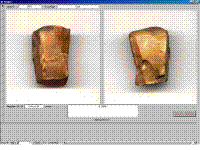
Figure 8: Illustration of coloured flint core (Accession ref: KINCM 1999.226.0001)
All data forms in the database have been locked, so that no data can be altered or added to. The author notes in the documentation that there is no access to any of the underlying data tables or queries, nor to the design of the database, which is 'read only'. Personally, I would have preferred to see an entity relationship model diagram in order to visualise how the various tables of the database interrelate, and to have a fuller functionality of Microsoft Access to carry out my own queries and to view field property metadata. This is probably a reflection of my background of working with SMRs in this area, latterly with the former Humberside and presently with North Yorkshire (and I should stress that I am viewing these CD-Roms by no means as a flint specialist, but as a curatorial archaeologist who has worked in the region for several years).
From the main menu, however, the user can choose to access a Reports menu, with options to view seven different pre-defined summaries and statistics of all the objects in the collection, for example by location or tool type.
As noted, the aim of the project was to create a database that may be applied not only to The Richard Harland Collection, but also to others. This has indeed been achieved, with some slight modifications, with the recent appearance of the Craven Museum Lithics Collections Database. This became available on CD-Rom in April 2003, designed and produced for the Craven Museum by Trevor Croucher, working in association with John Richardson.
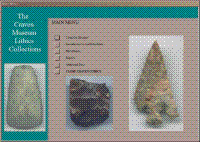
Figure 9: Main Menu of the Craven Museum Lithics Collection Database
Having viewed the Harland Collection database, I was immediately presented with a problem when trying to open the Craven Lithics Collection. Whilst the former is presented in Microsoft Access 97, the latter is in Access 2000, a version beyond the capabilities of my office computer! As the software is not backwards compatible, I had to wait to access another machine to view the data in Access 2000. Furthermore, if I had wanted to look again at the Harland Collection database whilst working at the same machine, the CD-Rom instructions warn me against converting the Access 97 database to 2000. Whilst it has currently been relatively easy for me to find machines running different versions of this software, I wonder if such access will be possible long-term? I have already referred to the restricted shelf-life of the CD-Rom format itself, but here we also have a problem with the long-term preservation and compatibility of the technology used to hold and view the data which it contains. These are both issues which should be considered at the outset of any major digitisation project such as this.
The documentation accompanying the CD-Rom notes that this interactive, illustrated database is the equivalent of a printed catalogue of over 7000 pages. It represents more than two years' work to document the museum's prehistoric lithics collection, comprising a total of 51,330 artefacts donated by more than fifty individual collectors over the past seventy years. The majority of these have come from the private collection of John and Bob Richardson, who have collected from Craven and adjacent areas since 1972. The remaining 2000 or so items comprise material previously donated to the museum by John Crowther, Lionel Atkinson, Arthur Waters, Welbury Holgate and Arthur Raistrick. The majority of these finds come from the Craven area of North Yorkshire, although items from outside the county are also represented, including a spread of material from West Yorkshire and Lancashire and beyond. A tremendous amount of thought and effort has gone into producing these catalogues. What a shame it would be if their accessibility was restricted by time limits imposed by the software and media used to create them.
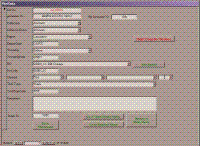
Figure 10: 'FlintData' form of the Craven Museum Lithics Collection Database
The main FlintData form differs slightly from that of the earlier Harland Collection database, with additional fields documenting the collection donor, and a separate button to provide extended site details, where available, including twelve-figure grid references in some instances. Such details and others, regarding material and tool types, for example, are also obtainable via additional forms accessed through the Data Forms menu.
As with the Harland Collection, objects were digitally scanned so that illustrations of all worked (non-waste) material could be incorporated into the database. Included are 3,788 pairs of illustrations showing a total of 15,383 worked objects. Some are individually illustrated, others are in groups, the pairs showing both sides of each artefact. I could, however, find no metadata recording the equipment used to scan the artefacts, nor any reference to the resolution of the images.
From the main Reports form (see Figure 11), a number of pre-defined report formats have been included, to enable the user to obtain a full listing of all the find sites represented in the collection, and the total number of objects from each one, as well as finds by tool type (with illustrations) and find sites by parish. This is a much extended list compared to the Harland Collection CD-Rom, and reflects the greater diversity of information about this much larger lithics collection.
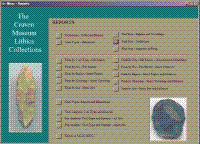
Figure 11: Menu of pre-defined Reports for the Craven Museum Lithics Collection Database
Both these CD-Rom virtual catalogues are a credit to their creators, having been produced with the aid of donations from a number of local organisations, including Richard Harland himself, The Pilgrim Trust, the Skipton Mechanics' Institute, the Robert Kiln Trust, the Council for British Archaeology and the Friends of Craven Museum.
For those interested in the study of the prehistory and the lithics of north and east Yorkshire, and beyond, these CD-Roms provide a valuable resource, bringing together a wealth of information about lithics from old collections, giving a common structure to data about material that has had varying levels of documentation. They provide electronic access to major collections of material from archives mainly in store and not on display.
Researchers will be able to undertake preliminary work without the need to travel to Hull and Skipton to visit the collections in person to select the items they may wish to view at a later date. By querying the databases in a number of ways, the researcher is able to identify objects specifically by accession number, thus saving both their own and the museum curator's time in locating items, and minimising the need to handle all of the material, thus reducing wear and tear.
There is much encouragement to make museum collections more accessible. As the report on a recent survey of archaeological collecting in the Yorkshire Region highlights, 'improved public access to archaeological material and records through museum exhibitions and displays, publications and electronic media is essential if archaeological material is not to be lost or disposed of inappropriately.' (Yorkshire Museums Council, 2000). Merriman and Swain (1999) and Perrin (2000) have also drawn attention to the need to give archaeological archives a higher value in the eyes of both the profession and the wider public, and to make data available to a wider audience to promote access and re-use.
Richards and Robinson (2000) have identified that most existing archive repositories are aware of, but have not yet confronted, the challenges of preserving digital datasets. This is an issue relevant to the data held on these CD-Roms, as the long-term preservation of not only the lithics collections themselves but also the digital data will need to be considered. Neither museum has its own detailed web presence yet, nor may they have the resources to curate digital datasets. The future, therefore, may be for them to contribute to more centralised digital web archives such as those held by the Archaeology Data Service (ADS). In this way, the digital data can be curated for the long term, and made available online to become accessible to a far wider audience through for example, the ArchSearch catalogue.
Whilst these CD-Rom catalogues are being publicised by the museums themselves and copies have been donated to local universities and libraries, I suspect that they have not so far been as widely used as they might. When writing this review, I searched the Internet for information about these items using Google but the handful of meaningful results that were returned hinted that very few people know about these CD-Roms yet. As the authors' aims with both these CD-Roms is to make the digital data from these collections available to as wide an audience as possible, surely the next logical step will be to make this material available online? In the three years since the appearance of the first catalogue in 2000, there has been rapid expansion in the use of the Internet for dissemination of digital data.
If online, the data could be made available to anyone who has access to the internet. I have already noted above the issue of the accessibility of the data with regards to requiring specific software. If held on a central server (either by the relevant museum, or through, for example, the ADS's ArchSearch catalogue), the data could be made available for users to search and download into whatever software they have to hand. Another benefit of the data being held centrally is that it then does not need to be a static catalogue. Data could be edited and updated if the collections grow, and then this need be done only on the central copy. On CD-Rom, however, the currency of the data is dependent both upon the lifespan of the medium itself, and on the point in time at which the data was compiled (as it stands any updates or addenda to the data would need to be issued as a supplementary CD-Rom). There are, therefore, longer term benefits to be had for the longevity of these lithic catalogues if they were to be curated as a digital online resource.
Nonetheless, the authors are to be congratulated on their achievements in documenting such a vast collection of material in such an innovative way. I hope that the outcome of this review will be twofold, both to raise awareness of the existence of these catalogues and promote their use, and to encourage those responsible for the datasets to consider their future curation and long-term access, and the potential of making them available online.
Merriman, N. and Swain, H., 1999 'Archaeological archives: serving the public interest?', European Journal of Archaeology 2:2, 249-67.
Perkins, P, 1997 'University archaeological education, CD-Roms and digital media', Antiquity 71, 1066-9 http://intarch.ac.uk/antiquity/electronics/perkins.html. Accessed 26 October 2002.
Perrin, K., 2002 Archaeological Archives: Documentation, Access and Deposition. A Way Forward. English Heritage
Richards, J.D. and Robinson, D. (eds), 2000 Digital Archives from Excavation and Fieldwork: Guide to Good Practice, Second Edition http://ads.ahds.ac.uk/project/goodguides/excavation/i ndex.html. Accessed 11 February 2003.
Schofield, J. 2000 Managing Lithic Scatters: Archaeological Guidance for Planning Authorities and Developers. English Heritage, doc. ref 2000 01.
Yorkshire Museums Council, 2000 Increasing Antiquity: Archaeology Collections and Collecting in Yorkshire and Humberside. Report on Yorkshire Museums Council Archaeology Collections Project.
* Gail Falkingham
Archaeologist
Heritage Unit
Environmental Services
North Yorkshire County Council
County Hall
Northallerton
DL7 8AH
Email: gail.falkingham@northyorks.gov.uk
© Internet Archaeology URL: http://intarch.ac.uk/journal/issue14/reviews/falkingham.html
Last updated: Wed 8 July 2003